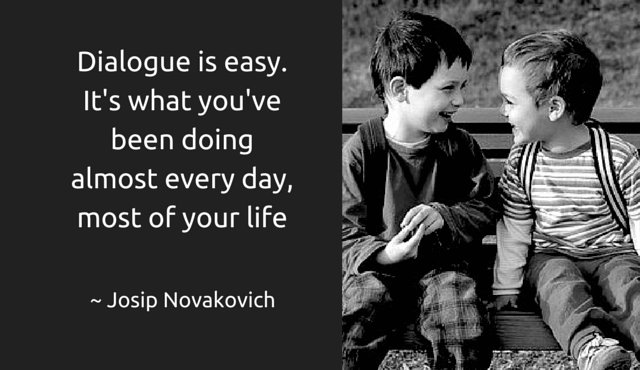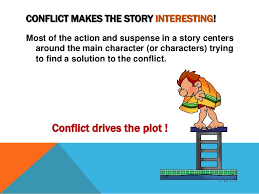Communication
| Site: | Cowichan Valley School District - Moodle |
| Course: | ELA10 - Spoken Language (2 credit), CSS, Cizeron |
| Book: | Communication |
| Printed by: | Guest user |
| Date: | Tuesday, 16 December 2025, 4:35 AM |
Table of contents
- Introduction
- Summary Explanation of Assignments
- ASSIGNMENT 1: Effective Conversation
- ASSIGNMENT 2: Dialogue
- Expository Writing
- ASSIGNMENT 3: Writing a Movie Scene
- ASSIGNMENT 4: Conflict
- ASSIGNMENT 5: Dramatic Reading
- ASSIGNMENT 6: Interview
- ASSIGNMENT 7: Editing Forum
- ASSIGNMENT 8: PROJECT: Advice from an Author
Introduction
Effective communication requires that we...
- Connect and engage with others
- Acquire, interpret and present information
- Collaborate to plan, carry out, and review constructions and activities
- Explain/recount and reflect on experiences and accomplishments
Consider all of these elements as you work through the assignments in this section.
Summary Explanation of Assignments
Here is a quick overview of the assignments for this unit. However, be sure you read over the specific assignment instructions that follow for each one. Review the marking rubrics for the assignments before you start.
ASSIGNMENT 1: Effective Conversation
Celeste Headlee has worked as a radio host for decades, and she knows the ingredients of a great conversation: Honesty, brevity, clarity, and a healthy amount of listening. In the following TED talk, she shares 10 useful rules for having better conversations. Watch this TED talk and write down the top 10 list demonstrating your own active listening.
ASSIGNMENT 2: Dialogue
Record a conversation and write an expository paragraph explaining how the conversation follows or doesn't follow Headlee's tips for effective conversation. Make sure you read over the explanation of good expository writing in the summary chart on the next page. It is important to know how to communicate clearly and effectively. Expository writing should be concise and accurately state your main idea.
ASSIGNMENT 3: Writing a Movie Scene
Here is your chance to write a conversation between characters that you create. Writing about characterization involves how characters are revealed through action, dialogue, and thoughts. A successful character analysis will discuss values and traits of a particular character, how the character undergoes change, and/or what he or she might represent. Review the different types of characters found in fiction and movies and learn about characterizing them. Then write a scene that SHOWS who they are as revealed by their dialogue. Be sure to correctly punctuate the dialogue.
ASSIGNMENT 4: Conflict
Conflict is a driving force in narrative writing. Create 2 characters and have them play out a conflict (or many conflicts), as you will read about in this lesson.
ASSIGNMENT 5: Dramatic Reading
You get to practice your own oration and dramatic skills now. Create a dramatic recording of your reading of an excerpt from Romeo and Juliet.
ASSIGNMENT 6: Interview
There are 2 options for this assignment. The purpose of this assignment is to provide students with a practical exercise in information-gathering interview skills while at the same time providing them with some information about possible career choices.
ASSIGNMENT 7: Editing FORUM
Practice your editing skills by re-writing the paragraph prompt in dialogue format.
ASSIGNMENT 8: PROJECT: Advice from an Author
Listen to a Canadian author read a selection from his work. Then write a personal response to his work, his conversation, or his suggested reading list. Do the writing assignment he suggests but we’re going to put a collaborative twist on his upside-down poem.
ASSIGNMENT 1: Effective Conversation
|
Learning Target (Curricular Competencies):
|
Celeste Headlee has worked as a radio host for decades, and she knows the ingredients of a great conversation: Honesty, brevity, clarity, and a healthy amount of listening. In the following TED talk, she shares 10 useful rules for having better conversations.
Task :
Watch this TED talk and write down the top 10 list demonstrating your own active listening.
Assessment:
Learning Target: (Exemplary 6/6): Exemplary comprehension of the task and clear accomplishment of the objective. Answers show evidence of active reading by accurately listing ten useful rules.
Submission:
Use the "2.1 Effective Conversation" link on the main page of this section of the course to upload your assignment to your teacher for marking.
ASSIGNMENT 2: Dialogue
|
Learning Target (Curricular Competencies):
|

Source: https://www.novel-writing-help.com/writing-dialogue.html
Task:
Record a conversation and write an expository paragraph explaining how the conversation follows or doesn't follow Headlee's tips for effective conversation. Make sure you read over the explanation of good expository writing in the summary chart on the next page. Be aware of your audience.
Submit the script from the conversation as well as the audio recording. Make sure you are using correct dialogue format.
- Here is some help in generating, punctuating, formatting dialogue.
- You might also consider using the dialogue to form part of a movie script. Read this site on How to Write a Movie.
- Here is a wikihow on How to Format Dialogue in a Story
Assessment: Below you will find the exemplary criteria used to assess the assignment.
Learning Target: (Exemplary 6/6): Exemplary comprehension of the task and clear accomplishment of the objective. Student demonstrates exemplary ability to develop and punctuate dialogue in personal, creative, and critical ways. Script is recorded using the correct dialogue format. Accomplishes the purpose with originality, individuality, and maturity and sophistication.
Written Expression: (Exemplary (6/6): Sentence structure and vocabulary are varied, skillfully written, and carefully chosen. Work has been proofread and there are few or no errors in spelling, capitalization, punctuation, and grammar. Content contributes to the central idea and makes insightful connections with logical organization.
Submission:
Use the "2.2 Dialogue" link on the main page of this section of the course to upload your assignment to your teacher for marking.
Expository Writing
Definition |
Expository writing will inform, explain, clarify, define, or instruct. |
| Characteristics |
|
| Sample Topics |
|
| Additional Websites |
ASSIGNMENT 3: Writing a Movie Scene
|
Learning Target (Curricular Competencies):
|
Task:
Here is your chance to write a conversation between characters that you create. Writing about characterization involves how characters are revealed through action, dialogue, and thoughts. A successful character analysis will discuss values and traits of a particular character, how the character undergoes change, and/or what he or she might represent.
1) Watch the video below to learn about the different types of characters found in fiction and movies.
2) Watch the video (below) on how to characterize them. Do you know the difference between indirect characterization and direct characterization?
3) Watch the wikihow on writing character sketches to better understand.
4) "Show, don't just tell" the characters. Reveal who they are by their actions as revealed by their words.
5) Submit your scene in whatever format you used to develop it. Each character should have at least 5 lines. Be sure you correctly punctuate their dialogue as you learned in the previous lesson.
Assessment: Below you will find the exemplary criteria used to assess the assignment.
Learning Target: (Exemplary 6/6): Exemplary comprehension of the task and clear accomplishment of the objective. Student demonstrates exemplary ability to develop and punctuate dialogue in personal, creative, and critical ways. Rich characters are developed using direct and indirect characterization.
Written Expression: (Exemplary (6/6): Sentence structure and vocabulary are varied, skillfully written, and carefully chosen. Work has been proofread and there are few or no errors in spelling, capitalization, punctuation, and grammar. Content contributes to the central idea and makes insightful connections with logical organization.
Submission:
Use the "2.3 Writing a Movie Scene" link on the main page of this section of the course to upload your assignment to your teacher for marking.
ASSIGNMENT 4: Conflict
|
Learning Target (Curricular Competencies):
|

There are 2 main types of conflict found in literature: internal and external. Watch the video on conflict to review the 3 types of external conflict and the one type of internal conflict.
Then demonstrate your understanding by engaging the characters you developed in the previous lesson in a conflict.
Task:
Write a short piece where your characters experience a conflict. Write the dialogue. How do they respond to it? What might they do? Is there a resolution? You can choose to write your characters into all the conflicts with short examples (2-3 lines each), or you can develop one main conflict in a longer piece. Just be sure to clearly identify which conflict (s) you have chosen.
You can submit your conflict dialogues in written form or in audio form or you can act them out and record.
Assessment: Below you will find the exemplary criteria used to assess the assignment.
Learning Target: (Exemplary 6/6): Exemplary comprehension of the task and clear accomplishment of the objective. Student creates a piece with characters in a clearly identified conflict with a reasonable response.
Written Expression: (Exemplary (6/6): Sentence structure and vocabulary are varied, skillfully written, and carefully chosen. Work has been proofread and there are few or no errors in spelling, capitalization, punctuation, and grammar. Content contributes to the central idea and makes insightful connections with logical organization.
Submission
Use the "2.4 Conflict" link on the main page of this section of the course to upload your assignment to your teacher for marking.
ASSIGNMENT 5: Dramatic Reading
|
Learning Target (Curricular Competencies):
|
You've been doing a lot of writing. Let's take a break and do some acting!

Shakespeare used two techniques to reveal the inner thoughts of his characters - an aside and a soliloquy. In an aside, a character breaks away from the other characters on stage and speaks directly to the audience. More commonly, Shakespeare had his main characters alone on stage speaking their innermost thoughts aloud in longer speeches called soliloquies. A monologue is a speech where one character addresses other characters
In As You Like It, the most famous soliloquy is a serious one about the passing of time and aging. The "All the world's a stage" soliloquy, which you will listen to shortly, is a perfect example of how Shakespeare uses rhythm and imagery to create memorable and innovative ways of using language.
Click the picture below to listen to the soliloquy from "As You Like It." Watch how the imagery is portrayed visually. Listen carefully, as you will be asked to perform your own dramatic reading.
Task:
Create a dramatic recording of your reading of an excerpt from Romeo and Juliet.
-
Dramatic! Bring energy and emotion to the words that you read. Make sure that your audience knows what you are feeling.
-
Effective! Use your voice to make your audience feel - fluctuate your volume, pitch, and rate of speech. Consider tone, diction, enunciation
- Entertaining! Your lively performance can make your audience laugh, cry…
Read the RUBRIC: Dramatic Reading before you record your oral presentation.
GETTING STARTED:
Step 1: Choose one of the excerpts from the list below to perform.
Step 2: Prepare your reading based on the notes created in the previous sections. Go back and listen to others performing your part. Make sure you understand what your character is saying, and his/her motivation.
Step 3: Practise, practise practise! Read the excerpt to a partner and get feedback for improvement.
Step 4: Record the excerpt. Play it back and give yourself a mark based on the evaluation guide. Then, make some final adjustments.
Step 5: Re-record - submit this final recording to your teacher for evaluation.
| Excerpts from Romeo And Juliet | |||
| I.i - Prince | II.ii - Romeo | II.iii - Friar | II.v - Juliet |
| III.i - Benvolio | III.ii - Juliet | III.v - Nurse | |
Recording your Dramatic Reading
Online:
Vocaroo is a very simple online recording program. When you have completed your recording, simply click the "Click here to Save." It will then give you sharing options. Please save the file to your computer (small blue links at the bottom of the box) and upload to the drop box.
Locally:
Audacity is a free application which you can load onto your computer. Don't forget to install the Lame plugin, which allows for saving to mp3 and other formats.
- Click here for a great Audacity tutorial website.
Assessment: Below you will find the exemplary criteria used to assess the assignment.
Learning Target: (Exemplary 6/6): Exemplary comprehension of the task and clear accomplishment of the objective. Oral reading is entertaining and captivating and captures the feeling of the excerpt.
Oral Presentation: (Exemplary (6/6): Delivery conveys powerful emotions and appropriate tone using dynamic inflection. Delivery seems natural. Speech is easily understood without mumbling, muttering or stumbling over words. Appears to have been thoroughly rehearsed. Pronunciation is accurate.
Submission:
Use the "2.5 Dramatic Reading" link on the main page of this section of the course to upload your assignment to your teacher for marking.
ASSIGNMENT 6: Interview
|
Learning Target (Curricular Competencies):
|
Effective communication is critical to success not only in dramatic performance or public speaking, but also in in business and life.
Concerned about an upcoming interview? Anxious about being asked to give your thoughts? Fearful about needing to provide oral critical feedback? Intimidated by an angry customer? You are definitely not alone. This assignment puts you in the driver's seat.
The purpose of this assignment is to provide students with a practical exercise in information-gathering interview skills while at the same time providing them with some information about possible career choices.
Task:
Option A
Students should locate a person (not a friend or family member) who currently holds approximately the same job and title that he or she hopes to hold in five years. Schedule a fifteen to twenty minute interview with this person. The student is the interviewer; this is NOT a fake job interview, it is a practical information-seeking interview in which the student hopes to find out everything possible to help them prepare for that position.
You should prepare a few open-ended questions. Here are some suggestions…
Suggested Questions:
- You may want to begin with career questions about the interviewee’s job title, duties, responsibilities, typical day
- Ask for advice about educational requirements for the job
- You may ask technical questions, if interested, that relate to your career choice
- Ask for personal advice, if appropriate (courses, internships, co-ops, study abroad)
- You may want to end with questions about the future, e.g., the company or industry in five years
- Ask a couple of environmental questions, e.g., does the company have environmental policies? Do they have a recycling program? Does the interviewee’s job deal with environmental issues? What are the environmental concerns within that industry?
- What do you like the most (or least) about the job?
- What is the impact of oral and written communication on your work and your progress in your profession?
These questions are only a beginning, you will certainly want to develop others so that you have a full sense of the demands and responsibilities of the position held by the interviewee and the nature of their field. Include a clear introduction and conclusion.
Submit
- your interview notes and the interview script.
- If you recorded it, you could submit that.
And now the panic begins. I have no idea about possible career choices! I am uncomfortable asking a total stranger to interview! Aaaaagh!
Option B
INSTEAD...Do all the background research on your possible career choice and do a mock interview with a friend and family member. You or your interviewee can be the “expert” in the field as you will have all the relevant information at your fingertips.
Submit
- Provide your research notes INCLUDING all the relevant citation information
- Your interview script. Include a clear introduction and conclusion.
- Your recording
IMPORTANT
Be sure to acknowledge your sources in MLA format. Read the handout on MLA CITATION in Class Handouts at the top of the course. Or use the Course Resource links at the side of the front page.
There are also a number of online sites that will generate your citations for you!! Try citationmachine.
Assessment: Below you will find the exemplary criteria used to assess the assignment.
Learning Target: (Exemplary 6/6): Exemplary comprehension of the task and clear accomplishment of the objective. A clear introduction and conclusion are included, and interview questions generate answers that are more than just one or two words. All parts of the selected assignment are complete. Student demonstrates the ability to access relevant and accurate information from diverse perspectives and from a variety of sources to respectfully exchange ideas and viewpoints and to build shared understanding and extend thinking .
Oral Presentation: (Exemplary (6/6): Interview is delivered in an interesting, clear and informative manner. Final product is of professional quality and demonstrates great attention to detail in its delivery. Spoken word can be clearly heard without distraction and is delivered with appropriate passion and inflection to support the overall message and inform the audience.
Submission:
Use the "2.6 Interview" link on the main page of this section of the course to upload your assignment to your teacher for marking.
ASSIGNMENT 7: Editing Forum
|
Learning Target (Curricular Competencies):
|
Task:
Dialogue is a conversation between two or more people. You've practiced it in this unit. Now demonstrate your editing skills.
- Dialogue is essential to fiction writing.
- Dialogue brings characters to life and adds interest.
- Dialogue must do more than just duplicate real speech.
- Writing dialogue consists of the most exciting, most interesting, most emotional, and most dramatic words.
Re-format the following paragraph into a dialogue. Focus on the starting each new conversation on its own line, using the correction punctuation, developing an appropriate voice. Use dialogue tags for each speaker. Feel free to embellish and change things, if you'd like. You could come up with your own scenario, too. Perhaps you've had a similar experience.
Tim was working the front counter/drive-thru at his fast-food job. A customer asked for extra pickles for her hamburger. Tim knew that when he rang it in to the till to let the back crew know, that the customer would be charged extra. He let the customer know that there would be an extra charge, as per store protocol. She went ballistic.
There are TWO activities in a FORUM:
- Go to the main page of the course and click on 2.7 Editing Forum. Start a new discussion topic by clicking on Add a New Discussion Topic.
- Reply/Respond to someone else's discussion topic by clicking on their topic and selecting Reply. Comment thoughtfully. Make an observation. Ask a question. Try using the following prompts to guide your response to another post. "I wonder…" "I know…" "I can…" Don't just agree or disagree.
Assessment: Below you will find the exemplary criteria used to assess the assignment.
Learning Target: (Exemplary 6/6): Exemplary comprehension of the task and clear accomplishment of the objective. Student demonstrates exemplary ability to develop and punctuate dialogue in personal, creative, and critical ways. Accomplishes the purpose with originality, individuality, and maturity and sophistication.
Response/Reply: Exemplary (6/6): The response/reply is thoughtful, insightful and respectfully exchanges ideas and viewpoints. Student demonstrates an exceptional level of understanding and communication of shared information.
Submission:
Use the "2.7 Editing Forum" link on the main page of this section of the course to post your forum response to your teacher for marking.
ASSIGNMENT 8: PROJECT: Advice from an Author
|
Learning Target (Curricular Competencies):
|
Task:
1. Watch this video featuring Stuart Ross from Cobourg, Ontario.
It has four sections:
- The Reading (the author reads their work to you)
- The Assignment (a writing exercise for you to do...)
- The Recommendation (a book or author that's a favourite)
- The Sign-Off (a piece of writing wisdom)
2. Respond to the video and Ross's reading by doing a one page reflection on his writing, his reading performance, his work, or connections that arise for you as he reads. This is your personal response. Should be 150 words.
3. Do the assignment he suggests. He wants you to create an upside-down poem. But let's put a fun twist on his assignment. See the assignment explanation below once you've watched the video and done your personal response.
4. If you want to expand your reading, Ross suggests you read W.A.C. Farrant: "Sick Pigeon" and "Raw Material"
Here's what you're going to do for this project...COLLABORATE!
1. Find 9 people and assign them a number (#1-#9). You are #10.
2. Then have them write a line of poetry on separate pieces of paper. Their line of poetry should include a poetic device: simile, metaphor, personification, alliteration, hyperbole, etc. You might have to teach them the meaning.
3. Make sure they write their names beside their line of poetry. Organize them from 1-10 on a page and Voila! There is your 10 line upside-down poem.
4. Then switch all the sentences around to create a different poem. You can do this many times.
5. Decide which one you like better and explain why in a clear paragraph.
Submit
1. Your personal response to the video
2. Your upside-down poem
3. Your poem preference explanation
Assessment: Below you will find the exemplary criteria used to assess the assignment.
Learning Target: (Exemplary 6/6): Exemplary comprehension of the task and clear accomplishment of the objective. Evidence of authentic collaboration is evident and all parts of the assignments are complete.
Ideas/Content: (Exemplary 6/6): Personal responses are unique, creative, specific and thoughtful.
Organization: (Exemplary 6/6): Ideas are well-organized and paragraphs include a strong topic sentence, insightful details and an engaging conclusion.
Written Expression: (Exemplary (6/6): Sentence structure and vocabulary are varied, skillfully written, and carefully chosen. Work has been proofread and there are few or no errors in spelling, capitalization, punctuation, and grammar. Content contributes to the central idea and makes insightful connections with logical organization.
Submission:
Use the "2.8 PROJECT - Advice from an Author" link on the main page of this section of the course to upload your assignment to your teacher for marking.